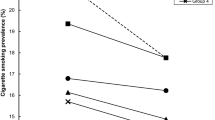Abstract
An environmental and economic evaluation of the smoke-free law in Massachusetts provides a broad appreciation of how a state-wide smoking ban affects the health of patrons and workers as well as the industries that are commonly concerned about the effects of smoking bans on business. The aim of this study is to evaluate environmental and economic effects of the statewide Massachusetts statewide Smoke-Free Workplace Law. Before and after the smoking ban, air quality testing was conducted in a sample (n = 27) of hospitality venues and state-wide economic changes were assessed. Compliance, in terms of patronage was measured by person-counts. Environmental outcomes were respirable suspended particles (RSP) less than 2.5 microns in diameter (PM2.5). Economic outcomes were meals tax collections, employment in the food services and drinking places and accommodations industries. On average, levels of respirable suspended particles (RSPs) less than 2.5 microns in diameter (PM2.5) decreased 93% in these venues after the Massachusetts Smoke-free Workplace Law went into effect. No statistically significant changes were observed among the economic indicators. This evaluation demonstrates that the state-wide Massachusetts law has effectively improved indoor air quality in a sample of Massachusetts venues and has not negatively affected several economic indicators.






Similar content being viewed by others
References
Massachusetts Smoke-Free Workplace Law: Executive Summary. Accessed May 6, at: http://www.mass.gov/dph/mtcp/resources/smoke_free_workplace_law_summary.doc
Glantz SA (1999) Smoke-free restaurant ordinances do not affect restaurant business. Period. Journal of Public Health Management and Practice 5: 9–10
American Non-Smokers’ Rights Foundation. Accessed June 17, 2006 at: http://www.no-smoke.org/goingsmokefree.php?dp = d13|p140
California Environmental Protection Agency: Air Resources Board, “Proposed Identification of Environmental Tobacco Smoke as a Toxic Air Contaminant” (June 24, 2005). Tobacco Control. Surveys and Program Evaluations from Outside UCSF. Paper CALEPA2005. Accessed May 13, 2006 at: http://repositories.cdlib.org/tc/surveys/CALEPA2005
Trichopolous D, Kalandidi A, Sparros L, MacMahon B (1981) Lung cancer and passive smoking. International Journal of Cancer 27:1–4
Eisner MD, Smith AK, Blanc PD (1998) Bartenders’ respiratory health after establishment of smoke-free bars and taverns. JAMA 280:1909–1914
Siegel M (1993) Involuntary smoking in the restaurant workplace: a review of employee exposure and health effects. JAMA 270:490–493.
Siegel M, Skeer M (2003) Exposure to secondhand smoke and excess lung cancer mortality risk among workers in the 5 B’s bars, bowling alleys, billiard halls, betting establishments and bingo parlours. Tobacco Control 12:333–338
Skeer M, Siegel M (2003) The descriptive epidemiology of local restaurant smoking regulations in Massachusetts: An analysis of the protection of restaurant customers and workers. Tobacco Control 12:221–226
Repace JL, Lowrey AH (1980) Indoor air pollution, tobacco smoke, and public health. Science 208:464–474
Invernizzi G, Ruprecht A, Mazza R, Rossetti E, Sasco A, Nardini S, Boffi R (2004) Particulate matter from tobacco versus diesel car exhaust: an educational perspective. Tobacco Control 13:219–221
Repace J (2004) Respirable particles and carcinogens in the air of Delaware hospitality venues before and after a smoking ban. Journal of Occupational & Environmental Medicine 46(9):887–905
Travers MJ, Cummings MJ, Hyland A, Repace J, Babb S, Pechacek T, Caraballo R (2004) Indoor air quality in hospitality venues before and after implementation of a clean indoor air law – Western New York, 2003. MMWR 53:1038–1041
Hyland A, Travers MJ, Repace JL. 7 City Air Monitoring Study, March-April 2004. Roswell Park Cancer Institute, May 2004.
Samuels B, Glantz S (1991) The politics of local tobacco control. JAMA 266: 2110–2117
Traynor M, Glantz S (1993) New tobacco industry strategy to prevent local tobacco control. JAMA 270
Dearlove JV, Bialous SA, Glantz (2002) Tobacco industry manipulation of the hospitality industry to maintain smoking in public places. Tobacco Control 11:94–104
Siegel M. Economic impact of 100% smoke-free restaurant ordinances. In Smoking and Restaurants: A Guide for Policy Makers. Berkeley: UC Berkeley/UCSF Preventive Medicine Residency Program: American Heart Association, California Affiliate, Alameda County Health Care Services Agency, Tobacco Control Program, 1992
Scollo M, Lal A, Hyland A, Glantz (2003) Review of the quality of studies on the economic effects of smoke-free policies on the hospitality industry. Tobacco Control 12: 13–20
Scollo M, Lal A. Summary of Studies Assessing the Economic Impact of Smoke-Free Policies in the Hospitality Industry. VicHealth Centre for Tobacco Control, Melbourne, Australia, April, 2004. Accessed May 13, 2006 at http://www.vctc.org.au/tc-res/Hospitalitysummary.pdf
Glantz SA, Wilson-Loots R. No association of smoke-free ordinances with profits from bingo and charitable games in Massachusetts. Tobacco Control 2003; 12(4), 411–413.
Bartosch WJ, Pope GC (2002) Economic effect of restaurant smoking restrictions on restaurant business in Massachusetts, 1992 to 1998. Tobacco Control 11(Suppl II): ii38–ii42
Glantz SA, Smith LR (1994) The effect of ordinances requiring smoke-free restaurants on restaurant sales. Am J Public Health 84:1081–1085
Glantz S (1997) Back to basics: Getting smoke-free workplaces back on track (editorial). Tobacco Control 6: 164–166
Mandel LL, Alamar BC, Glantz SA (2005) Smoke-free law did not affect revenue from gaming in Delaware. Tobacco Control 14:10–12
Centers for Disease Control and Prevention (CDC) (2000) Reducing tobacco use: a report of the Surgeon General. Atlanta, GA: US Department of Health and Human Services, CDC
Sargent RP, Shepard RM, Glantz SA (2004) Reduced incidence of admissions for myocardial infarction associated with public smoking ban: before and after study. BMJ 328:977–980
Skeer M, Cheng DM, Rigotti NA, Siegel M (2005) Secondhand Smoke Exposure in the Workplace. American Journal of Preventive Medicine 28(4):331–337
Monthly Revenue Reports. Massachusetts Department of Revenue, 2005. (Accessed October 7, 2005, at http://www.dor.state.ma.us/stats/RevRpt/index.htm
United States Department of Labor, Bureau of Labor Statistics, Current Employment Statistics Survey. Accessed May 13, 2006 at http://www.bls.gov/ces/home.htm
Massachusetts Tobacco Control Program. One Year Review of the Massachusetts Smoke-Free Workplace Law. M.G.L. Chapter 270, Section 22. (Unpublished report)
Author information
Authors and Affiliations
Corresponding author
Additional information
Support for this report was provided by the Flight Attendant Medical Research Institute.
Rights and permissions
About this article
Cite this article
Alpert, H.R., Carpenter, C.M., Travers, M.J. et al. Environmental and Economic Evaluation of the Massachusetts Smoke-free Workplace Law. J Community Health 32, 269–281 (2007). https://doi.org/10.1007/s10900-007-9048-6
Published:
Issue Date:
DOI: https://doi.org/10.1007/s10900-007-9048-6




